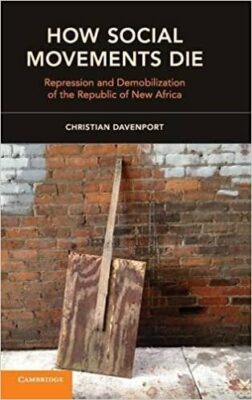-
“the demobilization of the RNA was connected with the organization’s largely failed approach at reappraisal of repression, but this did not account for the RNA’s demise by itself. Rather, it reinforced the loss of trust that resulted from the organization’s failure to achieve pursued goals, including the protection of organizational members from state repressive action. . . . My investigation of the RNA, however, revealed that the dissidents talked or thought about planned activity concerning previous repressive behavior for months, and occasionally for years, after relevant events occurred. In a sense, the analysis suggests that dissidents become carriers of repressive experiences, which they thereafter take with them into the social movement, affecting all who come across them. . . . 𝐭𝐡𝐞 𝐟𝐞𝐚𝐫 𝐨𝐟 𝐢𝐧𝐟𝐨𝐫𝐦𝐚𝐧𝐭𝐬 𝐚𝐧𝐝 𝐢𝐧𝐭𝐞𝐫𝐧𝐚𝐥 𝐬𝐮𝐛𝐯𝐞𝐫𝐬𝐢𝐨𝐧 𝐩𝐫𝐨𝐯𝐞𝐝 𝐭𝐨 𝐢𝐧𝐟𝐥𝐮𝐞𝐧𝐜𝐞 𝐑𝐍𝐀 (𝐝𝐞) 𝐦𝐨𝐛𝐢𝐥𝐢𝐳𝐚𝐭𝐢𝐨𝐧 𝐟𝐚𝐫 𝐦𝐨𝐫𝐞 𝐭𝐡𝐚𝐧 𝐚𝐧𝐲𝐭𝐡𝐢𝐧𝐠 𝐞𝐥𝐬𝐞, 𝐢𝐧 𝐩𝐚𝐫𝐭 𝐛𝐞𝐜𝐚𝐮𝐬𝐞 𝐢𝐭 𝐭𝐮𝐫𝐧𝐞𝐝 𝐞𝐯𝐞𝐫𝐲 𝐨𝐭𝐡𝐞𝐫 𝐦𝐞𝐦𝐛𝐞𝐫 𝐨𝐟 𝐭𝐡𝐞 𝐨𝐫𝐠𝐚𝐧𝐢𝐳𝐚𝐭𝐢𝐨𝐧 𝐢𝐧𝐭𝐨 𝐚 𝐩𝐨𝐭𝐞𝐧𝐭𝐢𝐚𝐥 𝐭𝐫𝐚𝐢𝐭𝐨𝐫. 𝐎𝐧𝐜𝐞 𝐩𝐞𝐫𝐜𝐞𝐢𝐯𝐞𝐝, 𝐭𝐡𝐢𝐬 𝐢𝐬 𝐡𝐚𝐫𝐝 𝐭𝐨 𝐨𝐯𝐞𝐫𝐜𝐨𝐦𝐞. . . . In the U.S. – RNA case, when the leader of the organization became aware of this dynamic (of members seeing each other as potential traitors and shutting off from further contact or communication), the members attempted to reestablish trust by decreasing the number of individuals to only the most trustworthy and starting again. 𝑵𝒐𝒕 𝒐𝒏𝒍𝒚 𝒘𝒂𝒔 𝒕𝒉𝒊𝒔 𝒊𝒏𝒆𝒇𝒇𝒊𝒄𝒊𝒆𝒏𝒕 𝒂𝒔 𝒕𝒉𝒆 𝒂𝒄𝒕𝒊𝒗𝒊𝒕𝒊𝒆𝒔 𝒐𝒇 𝒕𝒉𝒆𝒔𝒆 𝒊𝒏𝒅𝒊𝒗𝒊𝒅𝒖𝒂𝒍𝒔 𝒘𝒆𝒓𝒆 𝒊𝒏𝒇𝒊𝒍𝒕𝒓𝒂𝒕𝒆𝒅 𝒂𝒔 𝒘𝒆𝒍𝒍, 𝒃𝒖𝒕 𝒕𝒉𝒊𝒔 𝒊𝒏𝒆𝒗𝒊𝒕𝒂𝒃𝒍𝒚 𝒂𝒍𝒊𝒆𝒏𝒂𝒕𝒆𝒅 𝒕𝒉𝒐𝒔𝒆 𝒘𝒉𝒐 𝒘𝒆𝒓𝒆 𝒏𝒐𝒕 𝒂𝒎𝒐𝒏𝒈 𝒕𝒉𝒆 𝒊𝒏𝒏𝒆𝒓𝒎𝒐𝒔𝒕 𝒄𝒊𝒓𝒄𝒍𝒆, 𝒂𝒏𝒅 𝒊𝒕 𝒅𝒆𝒄𝒓𝒆𝒂𝒔𝒆𝒅 𝒕𝒉𝒆 𝒏𝒖𝒎𝒃𝒆𝒓 𝒐𝒇 𝒑𝒆𝒐𝒑𝒍𝒆 𝒊𝒏𝒗𝒐𝒍𝒗𝒆𝒅 𝒘𝒊𝒕𝒉 𝒎𝒐𝒗𝒆𝒎𝒆𝒏𝒕 𝒂𝒄𝒕𝒊𝒗𝒊𝒕𝒚 𝒂𝒔 𝒕𝒉𝒆 𝒑𝒐𝒐𝒍 𝒉𝒂𝒅 𝒃𝒆𝒆𝒏 𝒓𝒆𝒅𝒖𝒄𝒆. . . . In the end, the RNA was caught in a downward spiral in which repeated failures of reappraisal continued to reduce trust and, in turn, other internal dynamics beset the organization that are frequently highlighted by social movement scholars. One important negative influence was an organizational factor generally considered under the category of rigidity. 𝐎𝐯𝐞𝐫 𝐭𝐢𝐦𝐞, 𝐚 𝐬𝐦𝐚𝐥𝐥 𝐜𝐥𝐢𝐪𝐮𝐞 𝐨𝐟 𝐢𝐧𝐝𝐢𝐯𝐢𝐝𝐮𝐚𝐥𝐬. . . . 𝒉𝒊𝒏𝒅𝒆𝒓𝒆𝒅 𝒕𝒉𝒆 𝑹𝑵𝑨’𝒔 𝒂𝒃𝒊𝒍𝒊𝒕𝒚 𝒕𝒐 𝒂𝒅𝒂𝒑𝒕 𝒕𝒐 𝒄𝒉𝒂𝒏𝒈𝒊𝒏𝒈 𝒑𝒆𝒓𝒔𝒐𝒏𝒏𝒆𝒍 𝒂𝒏𝒅 𝒄𝒊𝒓𝒄𝒖𝒎𝒔𝒕𝒂𝒏𝒄𝒆𝒔 𝒃𝒆𝒄𝒂𝒖𝒔𝒆 𝒕𝒉𝒆𝒚 𝒍𝒂𝒓𝒈𝒆𝒍𝒚 𝒅𝒐𝒎𝒊𝒏𝒂𝒕𝒆𝒅 𝒕𝒉𝒆 𝑹𝑵𝑨 throughout the period under examination. Resource acquisition was a persistent source of tension as well, which fed into other organizational problems, both internal and external. Indeed, the more the RNA tried to do, the more money they tried to squeeze from their membership (especially the group in Detroit). this led to greater sacrifices, greater expectations about what would happen, and greater grievances when they did not.
Under all this weight, the individuals, institutions, and interventions largely demobilized. Although several individuals continued to engage in struggle, it seemed that ideas were the only elements of the claims-making effort that persisted. The dream of the black nation initially sparked by Malcolm X and later buoyed by Robert F. Williams within the relevant cohort of activists in Detroit continued, but nothing like how it was imagined. . . . The RNA versus U.S. government research teaches those interested in challenging political authorities a great deal about social movement demobilization. For example, guided by the preceding findings, if one were trying to mobilize, then one would need to be concerned with selecting individuals who are committed to an organization with a set of ideas and tactics but not so rigidly devoted to them that they are unable to adapt to situations around them.”




